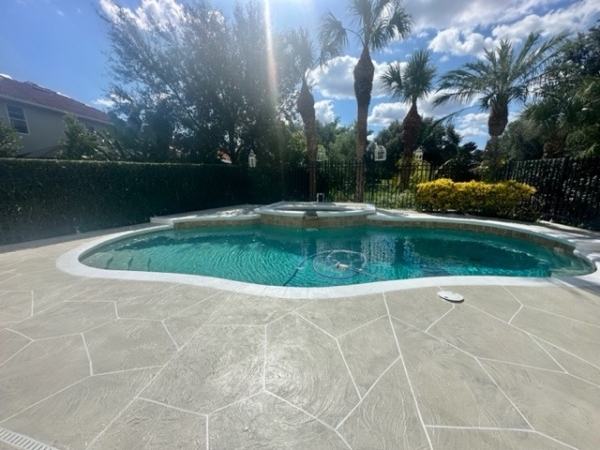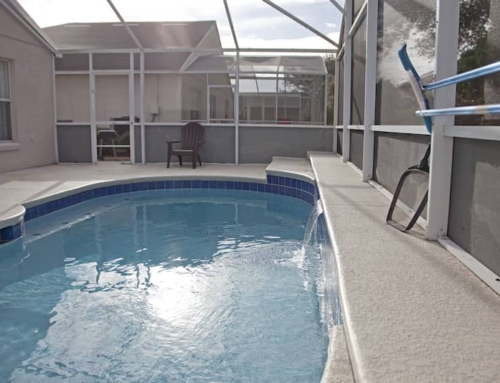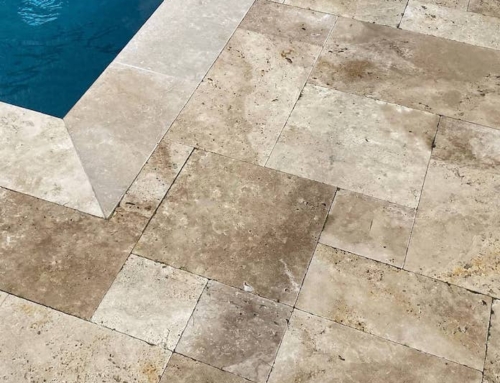Pool deck resurfacing is more than just an aesthetic enhancement. It’s about ensuring your outdoor living space’s safety, durability, and enjoyment. However, navigating the resurfacing process can be tricky, especially with various options like concrete coatings, stamped concrete overlays, and pool deck coatings.
While concrete pool decks are famous for their exceptional durability and low maintenance, common mistakes in the resurfacing project can lead to unsatisfactory results. From choosing the right concrete resurfacer to understanding the importance of surface preparation, we’ll delve into common errors in resurfacing pool decks and provide practical solutions.
Whether you’re a pool owner or a commercial property owner, avoiding these pitfalls will ensure your swimming pool area remains a safe, slip-resistant, and aesthetically pleasing haven for years.
Mistake 1: Inadequate Surface Preparation
Underestimating the significance of surface preparation is a common pitfall in resurfacing a pool deck. Proper preparation is not just a preliminary step; it’s a cornerstone for a successful resurfacing project. Here’s why it matters:
- Thorough Cleaning: Ensuring the existing concrete surface is free of dirt, debris, and old coatings is crucial. An unclean surface can hinder the adhesion of new concrete pool deck paint or coatings, leading to premature peeling and cracking.
- Repairing Cracks and Damage: Addressing any significant cracks or damage in the existing pool deck surface before applying a new layer is essential. Ignoring this can result in the new surface inheriting the same issues, compromising its integrity and appearance.
- Consequences of Skipping: Neglecting this vital step can lead to many problems. The new surface may not bond correctly, leading to issues like unevenness, reduced slip resistance, and a shorter lifespan, affecting your outdoor living space’s overall cost and safety.
Remember, a well-prepared surface lays the foundation for a smooth, durable, and aesthetically pleasing pool deck.
Mistake 2: Choosing Incorrect Resurfacing Materials
Selecting suitable materials for resurfacing your pool deck is crucial for durability and safety. Here’s a breakdown of why material choice matters:
- Variety of Options: Pool deck resurfacing options range from concrete overlays to cool deck coatings, each with benefits. Concrete provides a sturdy base, while stamped concrete overlays offer a unique and personalized look. On the other hand, cool deck coatings are excellent for harsh weather conditions and heavy foot traffic.
- Impact on Durability and Safety:
- Concrete and Stamped Overlays: While durable, they can be slippery when wet, raising concerns about fall incidents. Surface preparation and adding a slip-resistant layer are vital.
- Cool Deck Coatings: These offer better slip resistance and are cooler to the touch, enhancing safety around the pool area.
- Other Materials: Stone and tiles, though aesthetically pleasing, may not withstand pool chemicals or heavy traffic as effectively.
- Cost and Maintenance: The overall cost and ease of maintenance should align with your needs. Despite being cost-effective initially, some materials require more maintenance in the long run.
Mistake 3: Overlooking Professional Assistance for Pool Deck Resurfacing
Don’t underestimate the complexity of a pool deck resurfacing project. Here’s why enlisting professional help is a game-changer:
- Expertise in Complex Tasks: Professionals are skilled in handling complex aspects of resurfacing, such as dealing with significant cracks and ensuring even application of cool deck coatings.
- Quality Assurance: Hiring experts ensures high-quality work, especially in managing the intricate process of applying concrete overlays and stamped concrete overlays.
- Time and Cost Efficiency: Contrary to what you might think, professional services can be cost-effective. They bring efficiency and precision, avoiding the risk of costly errors and redo due to inexperience.
A well-executed resurfacing project not only enhances the look of your pool deck but also ensures its longevity and safety.
Mistake 4: Ignoring Environmental Factors
The Role of Weather and Climate
Environmental factors play a crucial role in the success of your pool deck resurfacing project. Weather conditions directly impact the performance and longevity of resurfacing materials like concrete overlay and stamped concrete overlay. Extreme temperatures or humidity can affect the curing process of coatings, leading to potential issues in durability.
Timing Is Everything
Choosing the right time for resurfacing is critical. Aim for stable weather to ensure the best conditions for your pool deck coating to set and cure properly. This strategic timing helps prevent future problems such as cracking or peeling, providing a long-lasting, beautiful pool deck surface.
Mistake 5: Neglecting Post-Resurfacing Maintenance
After investing time and effort into resurfacing your pool deck, it’s essential not to overlook the maintenance aspect. Regular upkeep is crucial for prolonging the life and appearance of your resurfaced pool deck. Neglecting this can lead to premature tear and wear, especially on concrete surfaces.
Tips for Effective Pool Deck Care
- Routine Cleaning: Keep your pool deck free from debris and dirt. It not only maintains its appearance but also prevents damage.
- Sealant Application: A sealant can protect concrete surfaces from moisture and wear, especially in high-traffic areas.
- Prompt Repairs: Address any minor pool deck repair needs immediately to prevent them from escalating into major issues.
Proper maintenance ensures your pool deck remains a safe and enjoyable part of your outdoor living space.
Mistake 6: Poor Planning for Drainage and Safety
One often overlooked aspect in resurfacing a pool deck is the drainage system. Effective drainage is vital to prevent water accumulation, damaging the pool deck, and creating safety hazards. Ensuring your resurfacing plan includes a well-designed drainage system is important for the longevity and functionality of your pool deck.
Prioritizing Safety in Material Choice and Design
- Slip Resistance: Choose materials that offer slip resistance, especially in wet conditions, to minimize the risk of accidents around the pool area.
- Material Durability: Opt for durable materials that can repel constant exposure to water and pool chemicals, ensuring a safer, longer-lasting pool deck.
Proper planning for drainage and safety is essential for a successful and sustainable pool deck resurfacing project.
Ensure a Successful Pool Deck Resurfacing
Successful pool deck resurfacing involves more than selecting a color or material. It requires thorough planning, understanding the role of environmental factors, and recognizing the importance of professional expertise, such as that offered by Creative Resurfacing Solutions. Here’s a quick recap and encouragement for your next project:
- Remember to prioritize proper surface preparation, choose suitable materials, and appreciate professional advice and execution.
- Factor in environmental considerations and regular maintenance to ensure the longevity of your pool deck.
- Approach your pool deck resurfacing with careful planning, and don’t hesitate to consult with skilled contractors to guide you through the process.
These steps will help ensure your pool deck is aesthetically pleasing, safe, and durable for years.







